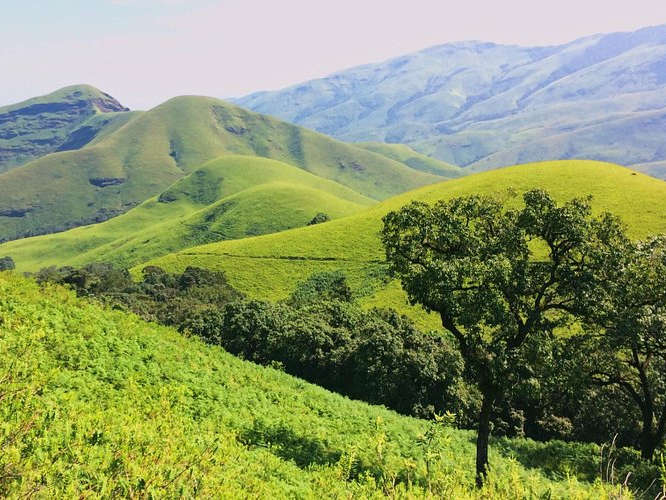The Green Trail of Karnataka: Unveiling the Kudremukh Trekking Experience


Tucked away in the heart of the Western Ghats, the Kudremukh Trek journey through one of India's most biodiverse regions. Known for its rolling hills, dense forests, and the iconic horse-face-shaped peak from which it gets its name (Kudremukh means "horse face" in Kannada), this trail offers a sublime blend of adventure and serenity. Whether you’re a seasoned trekker or a first-timer looking for a memorable trail, Kudremukh stands out as one of Karnataka’s most rewarding trekking experiences.
Where Is Kudremukh and Why Does It Matter
Located in the Chikkamagaluru district of Karnataka, Kudremukh is part of the Kudremukh National Park — a UNESCO-recognized biodiversity hotspot. The park spans over 600 square kilometers and forms a significant part of the Western Ghats, home to thousands of endemic species of flora and fauna.
The region is particularly known for its lush Shola forests, mist-covered valleys, and grasslands that resemble a green ocean under the monsoon skies. Its ecological importance has attracted attention from conservationists across India, making it a key area for sustainable eco-tourism.
What Makes the Kudremukh Trek Unique?
Unlike many treks in southern India that may feel more like nature walks, Kudremukh offers a true wilderness adventure. The trail spans approximately 9 kilometers one way (18 km round trip) and takes you through several distinct terrains — from open grasslands to shadowy forest patches and meandering streams.
Key highlights include:
Panoramic Views: The summit offers an unobstructed 360-degree view of rolling hills and valleys, often covered in a mystical blanket of clouds.
Wildlife Sightings: It’s not uncommon to spot deer, Malabar giant squirrels, langurs, and even signs of leopards or tigers deep in the forest, though actual encounters are rare.
Biodiversity: According to a 2021 report by the Indian Institute of Science (IISc), Kudremukh is one of the last remaining strongholds of the lion-tailed macaque — a critically endangered species found only in the Western Ghats.
Best Time to Visit
The ideal season for the Kudremukh trek is between October and February. Post-monsoon months offer clear skies, moderate temperatures, and greener-than-ever landscapes. The trail is accessible during the monsoon too, but the trek can be significantly more challenging due to slippery slopes and leech-infested patches.
Avoid trekking in peak summer (April to May) as the heat can be exhausting, and wildlife movement tends to be limited during these months.
Entry Requirements and Permits
Kudremukh is part of a protected area, so permits from the Kudremukh Forest Department are mandatory for all trekkers. The number of daily trekkers is limited to preserve the ecosystem, and it’s advisable to book your slot in advance. Permits usually include a small fee and the accompaniment of a local guide, which is compulsory.
Additionally, camping is strictly prohibited within the national park limits. Trekkers typically stay overnight at homestays in nearby villages like Mullodi, which also serve as the trailhead.
Trail Difficulty and Preparation
Rated as moderate, the trek doesn’t demand technical climbing skills but does require decent stamina. On average, it takes about 4-5 hours to reach the summit and another 3 hours to descend.
Preparation tips:
Wear high-traction trekking shoes (especially during or after monsoon)
Carry enough water (at least 2 liters per person)
Pack light but don’t forget essentials like rain covers, a first-aid kit, and insect repellent
Trekking poles are helpful for the steep descent
Responsible Trekking: A Shared Responsibility
With its increasing popularity, Kudremukh faces the threat of overtourism. Littering, noise pollution, and trail erosion have already prompted authorities to tighten rules. Trekkers are encouraged to follow Leave No Trace principles — carry back all waste, avoid using plastic, and minimize disturbance to wildlife.
A 2022 policy paper published by the Karnataka Eco-Tourism Board stresses the importance of local participation. Supporting homestays, hiring local guides, and engaging in community-driven conservation projects helps sustain the region both ecologically and economically.
How to Reach Kudremukh
By Air: The nearest airport is Mangalore International Airport, approximately 100 km away. From the airport, private taxis or buses can take you to Kalasa or Kudremukh town.
By Train: Mangalore Railway Station is the closest major railhead.
By Road: Kudremukh is well-connected by road to Bangalore (330 km), Chikkamagaluru (100 km), and Mangalore. Overnight buses and self-drive options are popular among city dwellers seeking a weekend getaway.
Homestays and Local Cuisine
The villages around Kudremukh — particularly Mullodi, Kalasa, and Samse — offer authentic Malnad hospitality. Most homestays are run by local families and include traditional meals made from farm-fresh ingredients: think akki rotti, kadubu, and bisi bele bath served with homemade pickles and fresh buttermilk.
These local stays are not just about comfort but also cultural immersion, giving visitors a taste of rural Karnataka life while supporting local livelihoods.
Conclusion
The Kudremukh Trek is not merely an adventure — it is a journey into the beating heart of Karnataka’s natural heritage. With its expansive meadows, rare wildlife, and eco-sensitive trail policies, it offers a trekking experience that is both exhilarating and humbling. Whether you seek solitude in the hills or the thrill of climbing one of the most scenic peaks in the Western Ghats, Kudremukh never disappoints.
As more travelers discover the trail, preserving its raw beauty becomes our collective duty. So lace up your boots, pack responsibly, and set forth on a trek that promises nature at its purest — a green trail worth every step.
Leave a comment